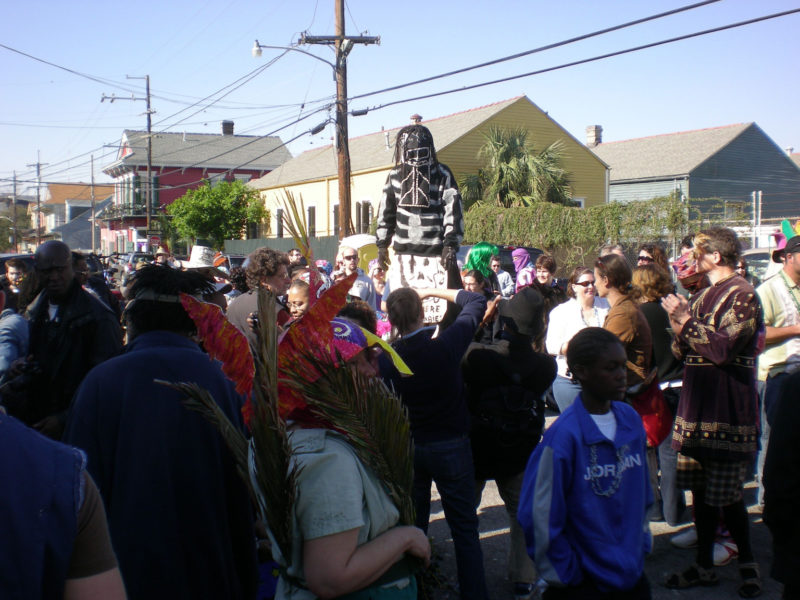
The Northside Skull and Bone Gang in Tremé on Mardi Gras morning. Photograph by Rick Hinterthuer.
Niya: Can you explain how you went about starting Free Spirit? Was it your first time performing African drum and dance in New Orleans?
Zohar: My dad, Robert Lee, he was a blues guitar player and his dad was a blues guitar player, Joe Lee. Joe Lee’s brother is a very famous blues guitar player they call John Lee Hooker. But Hooker was not his name. His name was Johnny Lee. And what happened was…I wanted to play guitar, and my dad wanted me to play guitar, but what happened was I was left-handed, and I would play the guitar upside down, plus it hurt my fingers. So I thought the guitar wasn’t for me. I thought it would be easier to play a drum, so I started to play drums.
The name Free Spirit comes from a band we had in the 70s. Most of them was students at Southern University, and the band was named Free Spirit, and after the band dispersed around the late 70s, I just held onto the name, and Free Spirit became an African drum and dance organization. At one time we had about 25 dancers in the group Free Spirit. And we had drummers, and we also had masquerades. Masquerades were the stilt dancers and also different masquerades they used in Africa.
In 1981 I was in Washington DC at Howard University, and there was a stilt dancer…I found out the guy was named Kumpo. I was so fascinated seeing the stilts, and I came back to New Orleans and after that I made some stilts, and started doing research, and 1986 I did my first performance dancing on stilts.
Niya: You taught yourself?
Zohar: Basically I taught myself. Because the stilt dancers is a secret society, and you have to be part of the society, part of that family, in order to get that knowledge. Even in New Orleans now they have classes where they teach kids stilt dancing. If you go to the Caribbean or places like that you can find organizations that teach stilt dancing, but it comes from an old African tradition that was very secretive. You never know who the masquerade was, and you never try to see him dress or anything like that. And you wore a mask, so that’s basically where that whole thing comes from in terms of the stilt dance. In 1986, there was a performance with Casa Samba, which is another group that I was in from the beginning, run by a brother named Curtis Pierre, and his wife Carol Pierre.
That was the beginning of the stilt dance Free Spirit. After that, we performed, we travelled, a lot out of the country. I actually travelled to England, to workshops. I performed in Bermuda, about ten years ago back and forth, bringing drums and knowledge of stilt dancing, and you know it’s very lucrative. I taught your father. I put him up on stilts, and in one week I sent him off to Florida to do a festival. And then from my understanding he taught you. And after him it was my other son, Judah, he’s a stilt dancer, Judah Israel, and my latest son, Solomon. So it’s a tradition that was really passed down through the family. And that’s how it became Free Spirit. It started with family members.
Niya: Was it your intention for it to get passed down that far?
Zohar: Yes, because that’s why it’s called tradition. It’s passed on and passed down. That’s part of the Hebrew culture: your first born son, you pass the knowledge to him, and his responsibility is to pass it on to his first born son. So that’s how you keep the culture alive, is to pass on. Cause if you die with it, it doesn’t go anywhere – it dies with you.
Niya: So my dad had said that you had given him his name…I think he said that once. Was that – when was that, that he changed his name?
Zohar: Oh wow, I don’t remember the year, you’d have to ask him that. But when he was in college, he’d just show up, come in town when I didn’t know he was coming. We would talk, hang out for a while, then a couple of days I wouldn’t see him again. So one of the last times, I think once he completed school and left, he came and started drumming with my organization Free Spirit, and I seen pictures of Shaka Zulu, and they have a similarity the way that they look. So I just figured that was a name that fit him: Shaka Zulu. And I think it had to be in the early to mid 1990s He held onto it; he got his name changed to Shaka Zulu. Person that have a bit of courage; all that tied to me choosing that name for him. I also introduced him to his wife.
 NOLAbeings
Multimedia artist Claire Bangser created NOLAbeings as a portrait-based story project that marries...
NOLAbeings
Multimedia artist Claire Bangser created NOLAbeings as a portrait-based story project that marries...
 Data corner: Adobe Suite (create a PDF, social media graphic, presentation, edit a photo and video
Data corner is where you go to work with analytics and top tech skills. It takes on everything from PERL and SQL to Canva and Sprout Social.
Data corner: Adobe Suite (create a PDF, social media graphic, presentation, edit a photo and video
Data corner is where you go to work with analytics and top tech skills. It takes on everything from PERL and SQL to Canva and Sprout Social.
